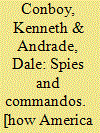| Srl | Item |
| 1 |
ID:
002126


|
|
|
|
|
| Publication |
Lexington, D C Heath and Co, 1990.
|
| Description |
xiv, 330p.
|
| Standard Number |
066920014X
|
|
|
|
|
|
|
|
|
|
|
|
Copies: C:1/I:0,R:0,Q:0
Circulation
| Accession# | Call# | Current Location | Status | Policy | Location |
| 033556 | 355.0218409597/AND 033556 | Main | On Shelf | General | |
|
|
|
|
| 2 |
ID:
047191


|
|
|
|
|
| Publication |
Kansas, University Press of Kansas, 2000.
|
| Description |
x, 347p.hbk
|
| Series |
Modern War Studies
|
| Standard Number |
0700610022
|
|
|
|
|
|
|
|
|
|
|
|
Copies: C:1/I:0,R:0,Q:0
Circulation
| Accession# | Call# | Current Location | Status | Policy | Location |
| 044711 | 959.70438/CON 044711 | Main | On Shelf | General | |
|
|
|
|
| 3 |
ID:
082143


|
|
|
|
|
| Publication |
2008.
|
| Summary/Abstract |
More than thirty years after the fall of Saigon, historians still argue about the lessons of the Vietnam War. Most fall into two schools of thought: those who believe that the United States failed to apply enough pressure - military and political - to the Communist government in Hanoi, and those who argue that the Americans failed to use an appropriate counterinsurgency strategy in South Vietnam. Both arguments have merit, but both ignore the Communist strategy, and the result is a skewed picture of what sort of enemy the United States actually faced in Vietnam. The reality is that the United States rarely held the initiative in Vietnam. Hanoi began a conventional troop build up in South Vietnam beginning in the early 1960s, and by the time of the US ground force intervention in 1965 the allies already faced a large and potent conventional Communist army in the South. Simply employing a 'classic' counterinsurgency strategy would have been fatal from the beginning. Despite this fact, the US military has tended to embrace flawed historical analysis to explain our failure, often concluding that there was a 'strategic choice' in Vietnam - a right way to fight and a wrong way. Most blame General William C. Westmoreland as choosing the wrong way and argue that if he had eschewed a big unit 'search and destroy' strategy, the war might have turned out differently. However, this article argues that this is untrue. Westmoreland could not have done much differently than he actually did given the realities on the ground. The flawed interpretations of the Vietnam War are not only bad history, but they also lead military and political policymakers to bad decisions in current counterinsurgency strategy. As the US military finds itself embroiled in unconventional wars in Iraq and Afghanistan, it needs clear lessons from America's longest counterinsurgency campaign - the Vietnam War.
|
|
|
|
|
|
|
|
|
|
|
|
|
|
|
|